I reviewed the 2.4L petrol Outlander, with CVT gearing, earlier this year and I gave it pretty good marks. So I had pretty high expectations for the diesel model. I’m pleased to say it didn’t disappoint.
The petrol model travelled quite smoothly, had ample room within its surprisingly large interior, and continued the good work of previous Outlanders, although in a somewhat less inspiring exterior design than predecessors. Its interior was greatly improved all round with tastefully toned soft plastics stretching from door to door across the entire dash and frontal area to give the vehicle a modern, up-to-date, appearance.
However, when I stepped into the diesel Outlander it was as though I’d stepped into another vehicle entirely. The interior was the same, still looking pin sharp and fresh with its revamped styling but it was from within the engine bay that the major changes were suddenly apparent. The 2.4L petrol never seemed sluggish, but the diesel by comparison was more than merely willing. It was quietly potent.
A slight depression on the right pedal and it would be answered with instant response. All sensation of CVT gearing wind up (common with the petrol version) was suddenly out the window with a smooth, seamlessly changing, six-speed auto unit. It combined brilliantly with the 2.2L turbo diesel engine to provide effortless response and very smart take off.
Impressive power and torque figures (110kW of power, 360Nm of torque), the four-cylinder diesel also exhibits remarkably low levels of noise, vibration harshness (NVH). This makes the Outlander a very refined, easy to enjoy wagon. And a very serious competitor for the likes of the Subaru Forester and Toyota Rav 4 SUV.
The Mitsubishi 2.2L intercooled turbo diesel engine is an advanced engine with double overhead cams, sixteen valves, and common rail fuel injection. Always smooth, even at initial start up, the diesel hummed gently at idle, with virtually no diesel rattle or clatter noticed at any time, even when under rapid acceleration. It was brilliant for higher speed touring on 110km/h limit roads, and equally smart when it came to overtaking at highway speeds as well.
The reviewed Outlander was the LS 4x4 model with seven-seater capacity. Not quite top of the range (as the Aspire models are at the sharp end of the six model stack) the LS nonetheless offered plenty of fruit for an owner. Head, leg, and shoulder room were all generous and there were a useful range of seating options available, especially suited for overall family use or for Mum’s school or sporting runs.
The 4WD capability is operated via a console-mounted button. Usual running mode sees 2WD as standard with four wheels ready for action when required. Bush tracks, paddock trails, the beach with careful entry and exit examination first, should all be within the Outlander’s scope.
The third row of seats can be retracted for level storage under the floor and would likely be best suited for use by children or small agile people. That aside, the seats are fine for short term carriage of passengers. Access to these two third row seats was through the sliding second row, which also featured a convenient 60/40 fold capability to assist entry or in carrying larger items.
Luggage capacity of the Outlander is quoted as 477L capacity with third row seating stored and five seats in use; the second row of seats also folds down creating an additional 1608L of luggage space.
Diesel or petrol model, the 2013 Outlander’s ride was very well controlled; with but a hint of body roll in corners, thanks to MacPherson strut coil spring suspension up front, a multi link set up with coils at the rear. The seating for front passengers is curiously hard but no doubt with some use the seats would become a little more user friendly.
The 4x4 LS offered quite a substantial amount of comfort and convenience features. A leather bound steering wheel and gear selector was standard, as was climate control air, rear seat heater ducts, pollen filter, side and window demisters. A multi information display with trip computer and elapsed fuel consumption, cruise control, Bluetooth, central door locking, power windows and mirrors, steering wheel audio and phone controls, plus a handy accessory power charging socket within the dash. All were standard within the well put together Outlander package.
Safety features abounded as well thanks to the Outlander’s five star ANCAP rating. Driver and front passenger will be protected by numerous side, curtain and other air bags including a driver’s knee air bag. ABS, EBD, Active Stability Control and Active Traction Control were standard, as was Hill Start Control and handy reversing sensors.
Rounding off the Outlander’s attributes are the Mitsubishi 3 year/130,000km warranty, a 2000kg braked trailer capability (which covers a lot of boats) plus fuel consumption of around 5.8-6L per 100km. Fuel tank is 60L capacity which suggests a very good touring range.
Last but not least is the fact that the Outlander carries a full sized spare under the cargo area. Price of the LS 4x4 Diesel as reviewed was $39,990, quoted by Nundah Mitsubishi.
Reads: 3533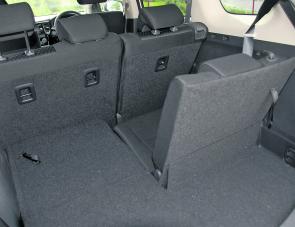
A third row of seating is offered within the LS Outlander; seats being stored under the floor when not in use.

With the Outlander’s third row of seats stored a flat cargo area of some 477 litres capacity is available.
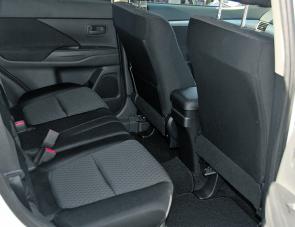
There’s ample leg room for second row passengers within the 2013 Outlander.
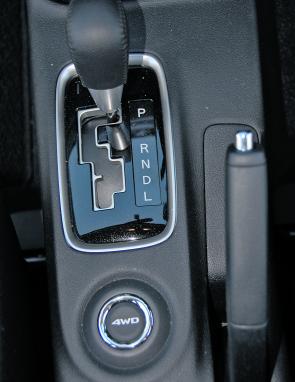
Four wheel drive can be locked in via a console mounted button.

The 2013 Outlander has a somewhat softened profile these days but is still an attractive vehicle.
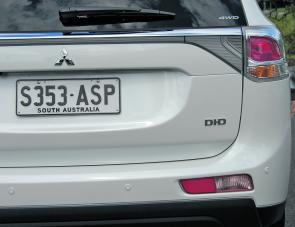
The small DiD badge on the tailgate of the Outlander is the only hint of the powerful diesel engine under the bonnet.
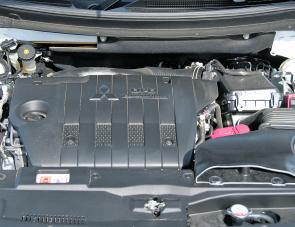
It’s only of 2.2 litres capacity but the Outlander’s diesel engine punches well above it’s weight.




